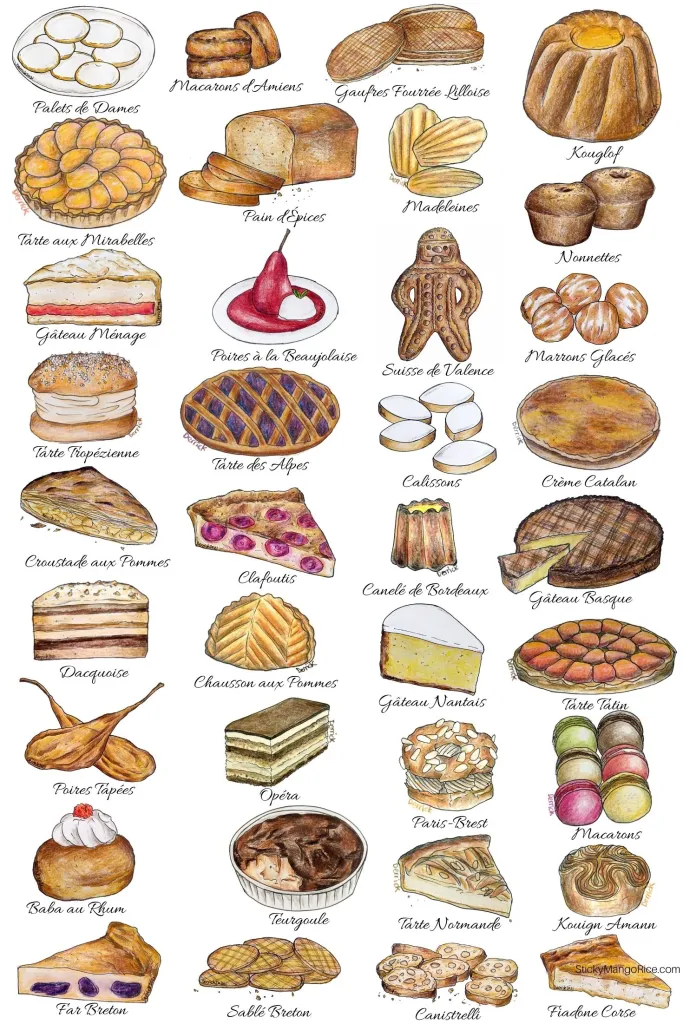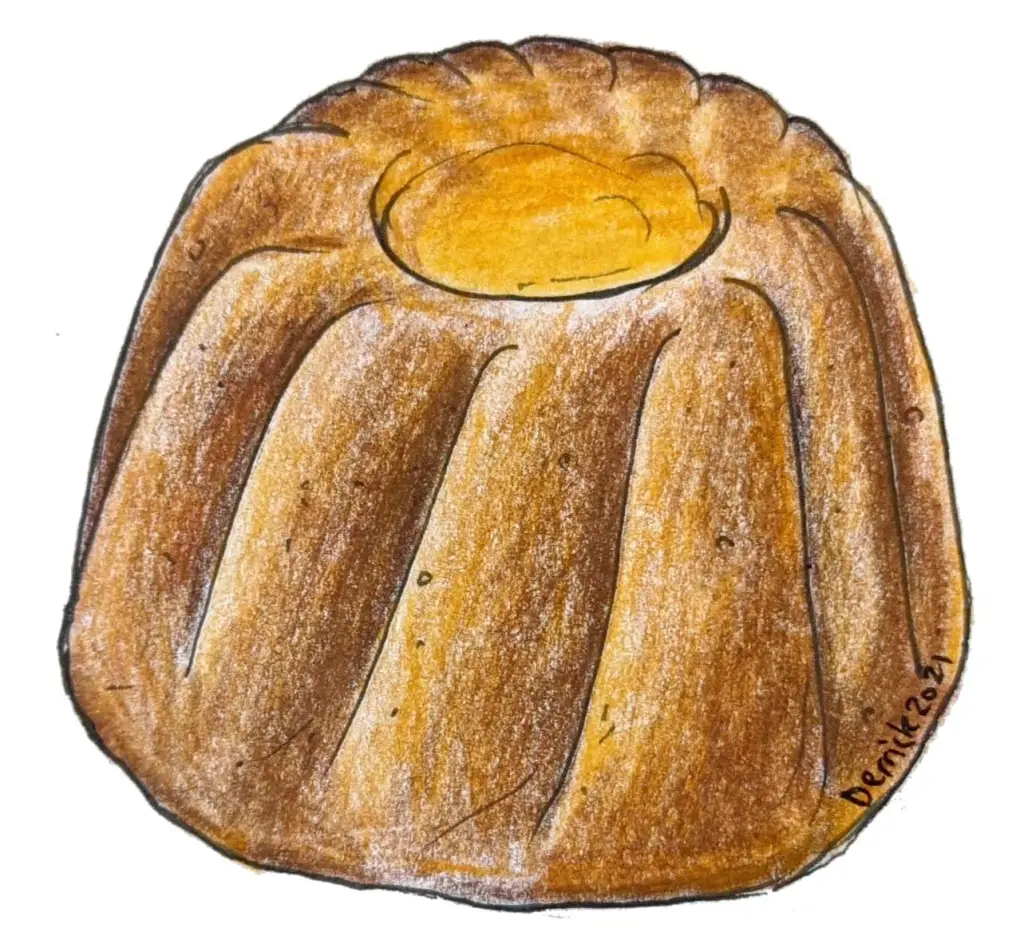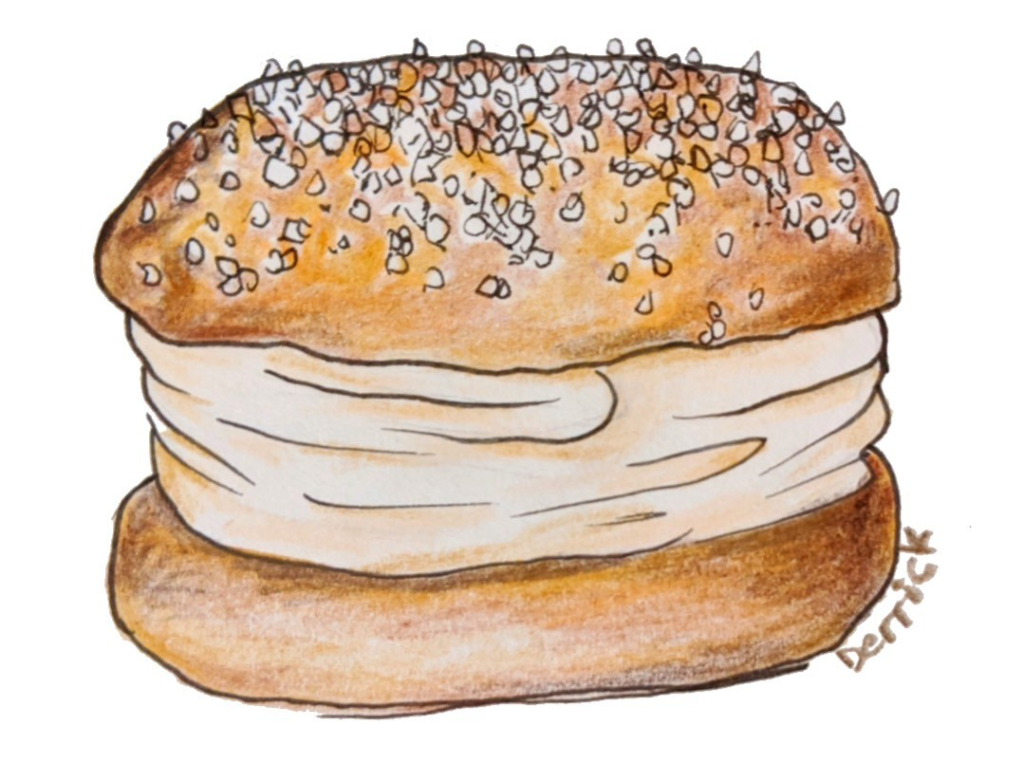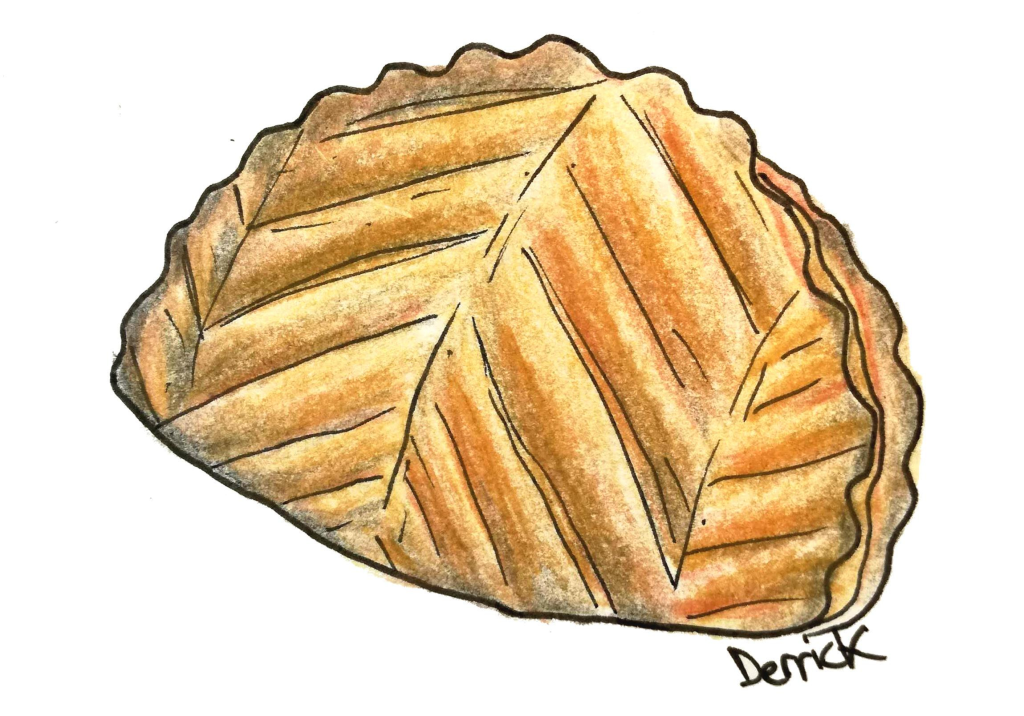When it comes to all things sweet, French desserts are some of the best in the world. They are celebrated for their creativity, taste, finesse, as well as their celebration of local ingredients. French desserts are influenced by their history and origins, local produce, neighbouring countries’ taste, and modern trends.
Many French desserts are world-famous classics served anywhere from the patisserie to the dining table, like the crème brûlée, the charlotte, crêpes suzettes, èclairs, or mousse au chocolat. But what about the regional specialities?
Looking at regional specialties of French desserts, we find butter biscuits and gingerbread, red wine pears and glazed chestnuts, waffles and rice pudding. While some may be relatively unknown outside of their place of origin, they are beloved by the locals that make them. Let’s take a closer look at some of France’s desserts.
Planning a gastronomic trip to France? Book your accommodation through Booking.com
Jump to a region
This post may contain affiliate links, which means I may earn a small commission, at no cost to you, if you make a purchase through a link.

Hungry for French sweets? France At Home is an online supermarket that delivers amazing French food right to your door!
Hauts-de-France
The northernmost region of France is Hauts-de-France, bordering Belgium in the north, and connected to England via the port city of Calais. The capital of the region is Lille, known for its beautiful architecture and lively open air markets. Hauts-de-France was the scene for many important battlefields of the 20th century, such as Vimy Ridge and Dunkirk.
Palets de Dames
Palets de Dames are small, round, vanilla flavoured cookies with a sweet glaze on top. The cookies have a soft, cake-like texture, and are sometimes baked filled with rum-soaked currants. They are named after their puck shape. The story of their invention goes back to the 18th century, when a French pastry chef is said to have been watching a game that a group of women were playing at the Palais Royal in Paris. The white glaze was supposed to represent the delicate clothing of the ladies.

Macarons d’Amiens
A different macaron from the Paris-style that many might find at Ladurée, this macaron is made from ground almonds, honey, eggs, sugar and fruit compote. While they lack the colour and lightness of the classic macaron, les macarons d’Amiens still have the distinctive outer shell crunch and soft inside, and go great with coffee.

Gaufres Fourrée Lilloise
Although the long history of waffle recipes dates all the way back to medieval times, today’s classic waffle recipe is generally thought to have been developed in Liège, Belgium in the 18th century. While the different kinds of waffles need no introduction, gaufres Fourrée Lilloise are a speciality of the north of France, which contain a filling of vergeoise. Originating in Lille, the vergeoise filling is made with sugar, butter and rum.

Grand Est
Grand Est is a diverse region of France that includes the Alsace, Lorraine and Champagne-Ardenne regions. The region is heavily influenced by neighbouring Germany, which can be seen in the culture and architecture of cities such as Strasbourg. Grand Est is the home of the world-renowned Champagne region, where authentic champagne is produced. Grand Est is also beloved for its beautiful villages, stunning castles like Château du Haut-Kœnigsbourg, and expansive national parks.
Kouglof
Popular in the Alsace region is the kouglof (also known as gugelhupf in neighbouring Germany), a tall yeast-based cake filled with cognac-soaked raisins and topped with hazelnuts. It is made in a circular Bundt mold, and the cake is often served with coffee and on special occasions.

Tarte aux Mirabelles
The tarte aux mirabelles is made with Mirabelle plums, a small, sweet fruit about as big as a cherry tomato. They grow in the Alsace-Lorraine region of France. The fruits have a protected origin, and can only be grown locally. The tarte has a base of shortcrust pastry, with a layer of custard or pastry cream. Then the mirabelles are added, sprinkled with mirabelle brandy and sugar, and caramelised under a blowtorch.

Pain d’Épices
Originally from the city of Reims, pain d’épices is a spiced cake made with rye flour, spices, and sweetened with honey. It has no egg or butter (just like bread), and the spices include cinnamon, ginger, nutmeg and cloves. It is baked in loaves, and commonly sold by the loaf or by the slice.

Madeleines
One can’t talk about the Grand Est without mentioning madeleines, the region’s most beloved small cake! Madeleines are fluffy sponge cakes with distinctive shell-shaped molds, and an almond taste. There are several theories about who invented them, but they’re thought to come from the cities of Commerce and Liverdun around the 17th or 18th century.

Bourgogne-Franche-Comté
The Bourgogne-Franche-Comté region is in the east of France, bordering Switzerland. This is the home of Dijon mustard and the world-class wine region of Burgundy, as well as outdoor adventures such as hiking in the Vosges Massif mountains, and skiing in the winter.
Nonnettes
Nonnettes are small gingerbread cakes sweetened with honey or orange marmalade, and topped with a lemon glaze. They were first baked during the middle ages by French nuns, which give their name – meaning ‘little nuns’ – to the sweet cakes. They are particularly popular in Dijon, where they can be bought from market stalls, or pre-made in supermarkets.

Gâteau Ménage
The gâteau ménage, which translates to ‘household cake’, is a simple and traditional cake from the Bourgogne-Franche-Comté region. Also known as a gâteau goumeau, it is a brioche-like cake with a top layer of goumeau, a creamy topping made with cream, egg and sugar. It sometimes contains choc chips, or a fruit filling, and is popular for birthdays and the festive season.

Poires à la Beaujolaise
Originating from the Beaujolais wine region is this French classic. It is made by soaking pears in red wine, spices such as cinnamon and cloves, and sweeteners such as honey. The pears are poached in the spiced wine sauce, and served with thickened sauce and sometimes a side of ice cream.

Auvergne-Rhône-Alpes
The mountainous alpine region of France is Auvergne-Rhône-Alpes, where western Europe’s highest peak is located; the one and only Mont Blanc. The region is famous for its natural beauty and diversity of landscapes, such as the river Rhône and its tributaries, the Beaujolais wine regions, the Alps mountains, and a chain of extinct volcanoes called the Chaîne des Puys. The capital of the region is Lyon, France’s second largest city and a gastronomic and historical jewel. Auvergne-Rhône-Alpes has many wonderful mountain cities, such Annecy, famous for its alpine lake and paragliding.
Suisse de Valence
The Suisse de Valence biscuit is a shortbread flavoured with orange peel and orange blossom, in the shape of a little soldier. The biscuit comes from the French town of Valence, and represents the Swiss guards of the Vatican, who accompanied Pope Pius VI, who died in 1799 in Valence. It is usually decorated with details to represent the soldier, with coffee beans for eyes, and baked with brushed egg and honey to give it its distinctive glazed finish.

Marrons Glacés
From southern France as well as northern Italy, marrons glacés are boiled chestnuts which have been candied in sweet sugar syrup. They are finished off with a sweet glaze, and either eaten as a snack, or used to make other desserts. Chestnuts are a popular snack in France, and are often roasted and eaten in the holiday period.

Provence-Alpes-Côte d’Azur
Provence-Alpes-Côte d’Azur is a diverse region that stretches from the Alps mountains range to the Mediterranean coast. It is the region of some of France’s most beautiful cities, such as Marseille, Nice, Cannes and Aix-en-Provence. Provence-Alpes-Côte d’Azur is a popular destination for its beautiful beaches, clifftop views and Cannes film festival. As well as having a beautiful and luxurious coastline, the region also has a lot of important historical sights, that range from well-preserved Roman ruins to medieval castles.
Tarte Tropézienne
The tarte Tropézienne hails from the French Riviera, also known as a tarte de Saint-Tropez. It was invented in 1955 by pastry chef Alexandre Micka, who used a brioche filled with vanilla cream, and sprinkled the top with crunchy pearl sugar, which is also found on chouquettes. The name was coined by one of Micka’s customers, Bridget Bardot, who was in France filming her new movie And God Created Woman.

Tarte des Alpes
The fruity tarte des Alpes is a traditional recipe from the Valgaudemar Valley in the Southern Alps. Known as a valley tart (tarte de lavallée), or queyrassine tart. It’s made with a sweet shortcrust pastry, filled with jam and covered with a lattice pastry topping. Common jam flavours include strawberry, blueberry, raspberry, apricot, forest fruits, cherry, and lemon. They are eaten hot or cold, and can be stored for several months if need by.

Calissons
A speciality of Aix-en-Provence, calissons are sweet candies made up of candied fruit such as melon or orange, almond meal, and a layer of icing fondant. They are known for their distinctive almond shapes, and could be described as similar to marzipan. Early versions of the calisson are mentioned in texts from 12th century Italy, but it’s thought that the Aix-en-Provence version originated around the 16th century. Today, they are geographically protected, with strict guidelines on how they are made.

Occitanie
With the Spanish border and the Mediterranean coast on its southern border, Occitanie is known for its Roman architecture, vast wine regions, spectacular castles and the Pyrenees mountain range. The capital of the region is Toulouse, nicknamed La Ville Rose (the pink city), for its signature pink-hued brick buildings. The gateway to the Languedoc-Roussillon wine region is Montpellier, a charming city full of beautiful architecture. When it comes to desserts, Occitanie borrows ideas from Spain, such as the Crème Catalan, a crême brulée with a citrus twist.
Crème Catalan
Crème Catalan is the Spanish rival of the crême brulée. While it’s not clear which was invented first, they are slightly different. Crème Catalan is made with cinnamon and citrus such as lemon or orange peel. It is made with a milk-based custard, and is finished off by caramelising the top layer with a blowtorch.

Croustade aux Pommes
The Occitan version of an apple crumble is the croustade aux Pommes, named after its crunchy top (croustade). It is made with apples from the region (sometimes soaked in armagnac, a brandy made in Gascony), wrapped in thin pastry and cooked until crispy. It is thought to date back to Moorish origins, which gives the dessert its distinctive flaky pastry sheets. Sometimes called ‘veil of the bride’ because of its thin pastry, it is often served at big events.

Nouvelle-Aquitaine
The largest region in France is Nouvelle-Aquitane, which has a border with Spain to the south, and the Atlantic coast to the west. Here, we find the city of Bordeaux and the surrounding wine region, Basque country near Spain, the porcelain-producing city of Limoges, the incredible Dune du Pilat sand dunes, Biarritz and it’s seaside resorts, and part of the Camino de Santiago pilgrimage walk. Nouvelle-Aquitane has an amazing 15 UNESCO World Heritage Sites alone, including the Vézère Valley prehistoric rock paintings.
Clafoutis
From the region of Limousin is this beloved classic, the clafoutis. Baked in a skillet or baking dish, a clafoutis is made with a custard-like batter (similar to a flan), traditionally filled black cherries of the Limousin region. When it baked, it puffs up like a soufflé, becoming golden on top and soft inside. When eating a locally made clafoutis, be warned – they are often baked with the cherry pits still inside.

Canelé de Bordeaux
Invented in Bordeaux, the canelé is a patisserie favourite that is known for its unique texture. Flavoured with rum and vanilla, these small cakes have a soft, gooey custard centre and a chewy, slightly crispy caramelised crust.

Gâteau Basque
Ubiquitous and adored in the Basque region of France, gâteau Basque is a cake made of a pastry dough of flour, butter and sugar, with a filling of black cherry jam (marked on top with a Basque cross) or vanilla pastry cream (marked with a cross hatch). Almond meal is often used, and it is brushed with egg to create a shiny texture on top.

Dacquoise
This chilled dessert is a layered cake made of a biscuit base, hazelnut and almond meringue, and buttercream. Many other variations exist, incorporating ingredients such as chocolate or strawberries. It is named after the city of Dax, with le biscuit dacquois translating to ‘cake from Dax’. Meringue has been popular in France since the 17th century, but it wasn’t until the 1790s that records of the dacquoise’s popularity began surfacing from French chefs working in England.

Pays de la Loire
Named after the Loire river and valley, Pays de la Loire follows the river all the way to Centre-Val de Loire. With Nantes as its capital, the region has a lot of rural towns and farmland. Local products include dairy, beef, pork, and poultry, as well as corn and wheat. It is home to the Puy du Fou, a historical theme park that features fully choreographed Viking raids, Gladiator combats and knights jousting, complete with siege weapons and pyrotechnics. The region also has some of France’s most beautiful Gothic cathedrals, castles, and the Le Mans racetrack.
Chausson aux Pommes
The chausson aux pommes is the French apple turnover from the Saint-Calais region, with a flaky puff pastry and a hot apple filling. While variations of the recipe exist all around the world, the Saint-Calais version is said to have originated during a citywide famine in 1630. The chatelaine (lady of the castle) distributed rations of apples and flour to the people, and this pastry was the result! Every year, Saint-Calais hosts the Fête de Chausson aux Pommes to celebrate the pastry.

Gâteau Nantais
The capital of Pays de la Loire, Nantes, is the birthplace of this decadent pound cake. The inside is soaked in rum, as is its characteristic white royal icing. When using butter, local salt butter is best, which gives it a salty twist.

Centre-Val de Loire
One of France’s central regions is Centre-Val de Loire, recognisable for its large numbers of grand Renaissance chateaux in the Loire Valley, and historically a favourite getaway for the kings and queens of France. The Touraine region is known as the ‘Garden of France’, for its vast plateaus of wheat fields. The dominant water source is the winding Loire River that passes the cities of Tours, Blois, and Orléans, the regional capital. Loire Valley wines are a famous product from the region. Sights include castles, Chartres Cathedral, and La Brenne wetland nature area.
Tarte Tatin
This apple pie is the quintessential upside-down cake in France. Slices apples are sprinkled with sugar, cinnamon and plenty of butter, covered in pastry, and baked until the apples caramelise. The cake is turned upside down when finished, so the apples are on top. The legend of the origin of the tarte tatin goes that in the 1880s, Stéphanie Tatin, the chef at the Hôtel Tatin near Orléans, neglected an apple pie she was making, which overcooked in butter and sugar. To try and save it, she put a crust over the top of the apples, baked it, and inverted the result. It was a smash hit, and together with a scoop of vanilla ice cream and créme fraîche, is one of France’s most popular desserts.

Poires Tapées
One of France’s oldest desserts are poires tapées, a dried and flattened pear from the Touraine region. The pear is dried out for several days in wood fired ovens, then mechanically squashed down to remove the air inside. This technique of drying pears is thought to date back to the 11th century as a method of preservation. While they can last a long time, they are best eaten hot and freshly dried, served soaked in wine, honey or spices.

Île-de-France
Île-de-France needs little introduction – it’s the region of Paris and its surrounding countryside. Paris is renowned internationally as a fashion capital, home of some of the world’s best art galleries, a hub of great literature and film, and of course, fine dining. It’s the city of the Eiffel Tower, Le Notre-Dame de Paris, and Versailles. Paris is also the birthplace is some of the most delicious desserts in France, such as the Paris Brest, opéra, baba au rhum, and millefeuille.
Macarons
One of Paris’ yummiest sweet treats are macarons. Coming in every flavour imaginable, macarons have two delicate and crispy meringue-based shells that sandwich a flavoured ganache in-between. The texture inside is moist, and these light treats melt in your mouth. They are thought to have come to France from Italy around 1533 with Catherine de’ Medici, but the present-day ‘sandwich’ version gained widespread popularity in the 1930’s with confection and baking company Ladurée.

Opéra
A classic of French boulangeries around the country, The Opera is a cake layered with almond sponge soaked with coffee flavoured syrup, chocolate ganache, and coffee buttercream. On top is a layer of rich chocolate glaze. The origins of the Opera are not clear, but are thought to have originated in a patisserie in Paris in 1955, named after the Palais Garnier opera building.

Paris-Brest
The Paris-Brest is a delicious choux pastry commonly found in many patisseries and boulangeries around the country. It is a wheel-shaped pastry sliced in two, filled with praline flavoured cream and topped with chopped almonds and icing sugar. It was invented in 1910 by pastry chef Louis Durand, who created the wheel-shaped pastry to promote a bicycle race from Paris to Brest in Brittany.

Baba au Rhum
The baba au rhum was invented in 1835 in Paris, and is based off a traditional Polish cake. It’s is a small yeast-risen sponge cake soaked in a syrup with rum. They are often filled with raisins, and served with crème Chantilly. The inventor is generally thought to be Nicholas Stohrer, the personal chef of Marie Leszczyńska, wife of King Louis XV.

Normandy
The Normandy region lies on the Atlantic coast, facing England across the English Channel (La Manche). While Normandy sometimes conjures up images of the D-Day beach landings during WW2, the region has a long and interesting history stretching back millennia. Named for the Normans, Normandy has been the home of Celtic tribes, oversaw Roman conquest, and changed hands between Germanic tribes, Saxons and Viking raiders. Coalescing as the Duchy of Normandy, the region came under Anglo-Norman rule, and eventually, the French monarchy. Normandy is visited for its stunning Abbaye du Mont Saint-Michel, Claude Monet’s Giverny gardens, the cliffs of Étretat, and is home to the medieval Bayeux Tapestry. In Norman desserts, apples reign supreme, as found in the tarte Normande, the region’s signature apple tart.
Teurgoule
This Norman rice pudding is made with milk, rice, sugar, cinnamon, and nutmeg. Traditionally baked in a terracotta terrine for hours, the dish is famous for its delicious, crispy crust of caramelised sugar. The name comes from the French se tordre la gueule (to twist one’s mouth), due to the reaction of some people to the spices. The recipe is kept by le Confrérie des gastronomes de Teurgoule et de Fallue de Normandie, (The Brotherhood Of Teurgoule), who dress in green and orange ceremonial robes, and organise the teurgoule cooking contest in Houlgate.

Tarte Normande
The tarte Normande is Normandy’s version of the apple pie. A shortcrust pastry is topped with apples, chopped almonds and baked in egg custard until set. Calvados, an alcoholic spirit from Normandy, is also sometimes added. The top forms a caramelised layer, and the inside is a mixture of thick apple slices and egg custard.

Brittany
Brittany reaches out into the Atlantic along a hill-studded peninsula on France’s west coast. Brittany has a proud history of Celtic history and tradition, and is home to the ethic Breton people. Rennes is the capital city of the region, known for its beautiful architecture, large public parks, and old town. Brittany is home to numerous ancient megalithic sites such as Carnac, a series of stone arrangements where over 3000 giant stones date back to 4500BCE. This is also the region of the fortified seaside city of Saint-Malo, and the medieval walled city of Vannes. Salted butter, a Breton speciality, is used is many desserts including the famous kouign amann, and salted butter caramel.
Kouign Amann
The kouign amann is a Breton speciality, and jokingly referred to as one of the most fattening pastries in France. The name (pronounced something like quinn-ah-manh) translates to ‘butter cake’, and is made with a dough-butter-sugar ratio of 40-30-30. When it bakes, this pastry caramelises and expands, giving it a delicious crunchy outside, and a buttery centre.

Far Breton
Similar to a flan or clafoutis, the far Breton from Brittany is a tart made with a base of egg and milk custard. For Breton speakers, the clue is in the name; the Breton word for flan is far. It has a dense texture and a golden brown crust. The tart is often filled with fruit such a prunes or raisins, which can be soaked in alcohol such as Armagnac. Far Breton originated in the 18th century as a version without fruit, eggs and butter, but evolved over time into the desert eaten by many today.

Sablé Breton
Brittany’s most famous biscuit is the sablé Breton, a crumbly shortbread biscuit made with plenty of delicious French butter. In Breton, they’re known as traou-mad, which translates to ‘good things’. They are best enjoyed as a snack, or with coffee.

Corsica
Corsica is located in the Mediterranean Sea, the only French region of metropolitan France which is not connected to the mainland. After Sicily, Sardinia and Cyprus, it is the 4th largest island in the Mediterranean. It has a mountainous landscape of thick forests which are popular with hikers, whilst the gorgeous sandy beaches are ideal for snorkelling and sunbathing. Corsican desserts are influenced by neighbouring Italy, and utilise local ingredients specific to the island. One example is brocciu, a locally made goat’s cheese used in the fiadone Corse cheesecake.
Canistrelli
Canistrelli biscuits are perfect for dunking in coffee. Their name means ‘little baskets’, and are small shortbread biscuits that originate from Italy.

Fiadone Corse
Fiadone is a traditional lemon cheesecake, made with its signature ingredient, brocciu (a Corsican cheese made from milk and whey from a goat or sheep). The cheese is similar to ricotta, but has more of a strong taste. It contains eggs, sugar, and lemon.

***
France has some of the world’s finest desserts. While many of them are famous in bakeries and patisseries across the world, such as éclairs, macarons, crèmes brûlées and flans, there are countless others which are regional specialities. From fruit-filled alpine tarts, waffles from the north filled with vergeoise, rum-soaked cakes in Paris, and even flattened pears, the world of French desserts is full of new things to discover.